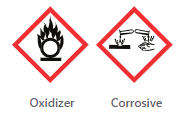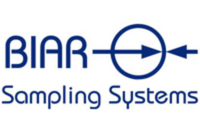Determining Nitric Acid Strength
Nitric acid is highly corrosive and is also an oxidizer. When nitric acid reacts with water, it also generates heat.
Why sample Nitric Acid?
- To ensure acid strength and purity
What to Look for in the Sample
- Acid Strength
- Sulfates & Chlorides (Spectrophotometric Method)
- Fluorides (Ion Electrode Method)
- Iron (Inductively Coupled Plasma (ICP) Spectroscopy)
How to Safely Take Nitric Acid Samples
- BIAR Multi-Function 304L or PFA-lined inline sample valve with spring-to-close function
- Thread Adapter or Bottle Support
- Safety Cabinet (vented)
- Safety Plug (for secondary containment)
- Use open containers such as plastic bottles
Because nitric acid is extremely corrosive, 304L stainless steel or PFA-lined sample valves are considered a better option due to their low carbon content and corrosion resistance to nitric acid.
A BIAR inline sample valve with a thread adapter allows the bottle to be screwed directly onto the valve and allows the fumes to be vented away from the operator with a vent connection at the back of the valve. This feature also prevents the buildup of pressure inside the bottle.
Given the fact that nitric acid fumes are dangerous, it is useful to have a suitably vented safety box to reduce the risk of operator exposure.
Nitric Acid
1) Description
Name: ..............................................................................................Nitric Acid
Chemical Formula: .....................................................................HNO3
CAS No: ..........................................................................................7697-37-2
Other Names: ...............................................................................aqua fortis, hydrogen nitrate, red fuming nitric acid, white fuming nitric acid, engraver’s acid.
Uses: ...............................................................................................Industrial
Physical state: ..............................................................................Liquid
Color: ..............................................................................................Colorless, yellow, or red, fuming liquid
Odor: ...............................................................................................Acrid odor
Boiling Point: ................................................................................83°C (181°F)
Melting Point: ...............................................................................-41°C (-44°F)
Flammability (solid, gas): ..........................................................N/A
2) Hazards
Nitric Acid is considered Immediately Dangerous to Life or Health (IDLH) by NIOSH (1994).
Noncombustible Liquid, but increases the flammability of combustible materials.
H290: May be corrosive to metals.
H314: Causes severe skin burns and eye damage.
H330: Fatal if inhaled.
H370: Causes damage to organs.
H372: Causes damage to organs through prolonged or repeated exposure.
Reactivity: Combustible materials, metallic powders, hydrogen sulfide, carbides, alcohols Note: Reacts with water to produce heat. Corrosive to metals.(NIOSH)
Specific Hazards related to Sampling: Nitric acid is extremely corrosive and can cause severe burns. It can be sampled into a bottle, but nitric acid mists are also highly dangerous and fumes must be kept away from the operator using a good ventilation system.
_________

3) Sampling Facts
Plants need to verify the strength of the acid as it is produced in varying strengths.
Acid strength on a regular basis.
More stringent tests for:
Sulphates: Spectrophotometric Method
Chlorides: Spectrophotometric Method
Fluorides: Ion Electrode Method
Iron: ICP (Inductively Coupled Plasma) Spectroscopy
4) Most common Sample Receptacles
Nitric Acid is sampled into open-top containers such as plastic bottles.


